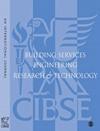Prediction of mould growth rate within building envelopes: development and validation of an improved model
IF 1.8
4区 工程技术
Q3 CONSTRUCTION & BUILDING TECHNOLOGY
Building Services Engineering Research & Technology
Pub Date : 2022-11-03
DOI:10.1177/01436244221137846
引用次数: 1
Abstract
Mould growth is a common problem in building envelopes. This issue is usually caused by poor design and construction of walls and results from the difference between indoor and outdoor climatic conditions. Mould spores produced by mouldy walls may diffuse into the air, thereby affecting indoor air quality and threatening occupant health. Therefore, it is important to predict the risk of mould growth in building envelopes under various conditions. This study selected three buildings from a traditional community in Shanghai, China. First, the mould species in these building envelopes were identified. Based on the identification results, the growth rate of the corresponding genera was extracted from the literature to establish an isoline model that describes mould growth on the agar surface. In addition, the mould growth rate between and outside the isoline areas was predicted by modifying the Sautour model to relevant air temperature and humidity conditions. According to the results of the proposed model, the critical temperature and humidity that allow the growth of representative moulds from the buildings selected for this study can be expressed as φ=0.002633·cosh[0.10083·(θ-30)]+0.7153. The accuracy of the above model was verified experimentally, and the maximum relative error of the growth rate was within 25%.建筑围护结构内霉菌生长速率的预测:改进模型的开发和验证
霉菌生长是建筑围护结构中常见的问题。这个问题通常是由于墙壁的设计和施工不当以及室内外气候条件的差异造成的。发霉的墙壁产生的霉菌孢子可能扩散到空气中,从而影响室内空气质量,威胁居住者的健康。因此,对不同条件下建筑围护结构的霉菌生长风险进行预测具有重要意义。本研究选取了中国上海一个传统社区的三栋建筑。首先,确定了这些建筑围护结构中的霉菌种类。根据鉴定结果,从文献中提取相应属的生长速率,建立描述霉菌在琼脂表面生长的等值线模型。此外,通过将Sautour模型修改为相应的空气温度和湿度条件,预测了等温线区域内外的霉菌生长速度。根据所建模型的结果,本研究所选建筑物中具有代表性的霉菌生长的临界温度和湿度可表示为φ=0.002633·cosh[0.10083·(θ-30)]+0.7153。实验验证了上述模型的准确性,生长速率的最大相对误差在25%以内。
本文章由计算机程序翻译,如有差异,请以英文原文为准。
求助全文
约1分钟内获得全文
求助全文
来源期刊

Building Services Engineering Research & Technology
工程技术-结构与建筑技术
CiteScore
4.30
自引率
5.90%
发文量
38
审稿时长
>12 weeks
期刊介绍:
Building Services Engineering Research & Technology is one of the foremost, international peer reviewed journals that publishes the highest quality original research relevant to today’s Built Environment. Published in conjunction with CIBSE, this impressive journal reports on the latest research providing you with an invaluable guide to recent developments in the field.
 求助内容:
求助内容: 应助结果提醒方式:
应助结果提醒方式:


